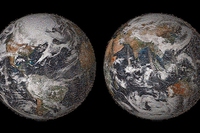
Environmental activists are in danger more than ever
In 2014, the number of environmental activists murdered has increased. Brazil is the most dangerous country for environmental defenders.
In 2014, the number of environmental activists murdered has increased. Brazil is the most dangerous country for environmental defenders.
The National Aeronautics and Space Administration (NASA) is the US government space agency that has always been active in monitoring, defending and celebrating the Earth’s beauties. On the occasion of Earth Day, celebrated on 22 April all around the world, NASA released a series of extraordinary pictures of our planet. The photo gallery includes some of the most beautiful pictures
La vera portata del disastro ambientale è ancora in fase di studio, la National Wildlife Federation ha però pubblicato uno studio sugli impatti sulla biodiversità.
Capybaras spend most of their time in the water, and guinea pigs are their closest parents. Here you can find some facts about these funny animals.
The Canadian segment of the Rocky Mountains could undergo a drastic transformation, in less than 90 years. In fact, according to study carried out by the University of British Columbia and published by Nature Geoscience, Canada is likely to lose 70% of its glaciers by 2100, due to global warming. The province of
The number of cities choosing renewable energy is increasing. British Columbia’s largest city approved the motion.
Freeing dogs on chains is the mission of an important organization set up in the United States.
Between 2009 and 2012 Brazil and Indonesia were given 346 million dollars by the U.N. – mostly from Norway and Germany – to preserve rainforests. But this good piece of news is completely omitted in the report written by the Overseas Development Institute (ODI), according to which in the same period those countries have spent
In order to curb CO2 emissions and global warming, the vegetation on the Earth is doing its best. Over the last decade, trees and plants all over the world have stored 4 billion tonnes more of greenhouse gases, thanks to reforestation projects in China, to an increase of forests in some countries of the former
Antarctica, otherwise known as the sixth continent, recorded an increase of 70% in the rate of shrinking over the last decade (1994-2003). The thickness of ice shelves in the South Pole is thinner and thinner, and it could even halve within 200 years. The research containing the data was published by Science magazine,








